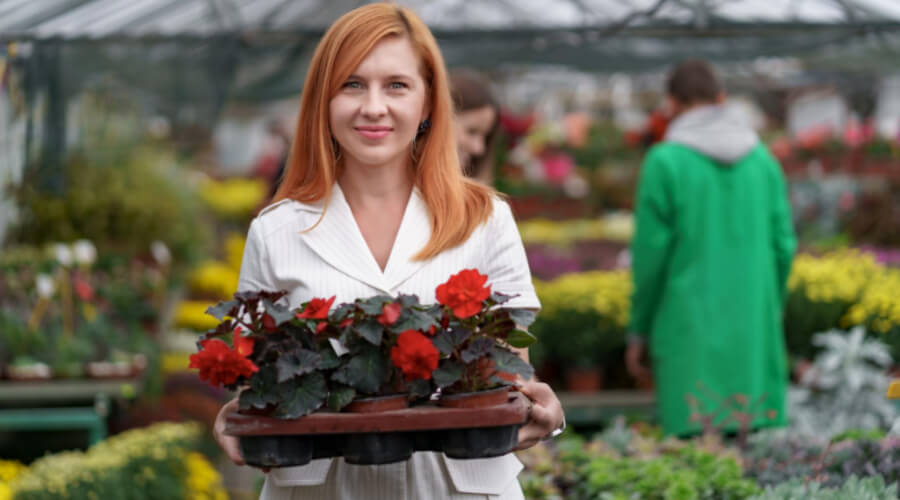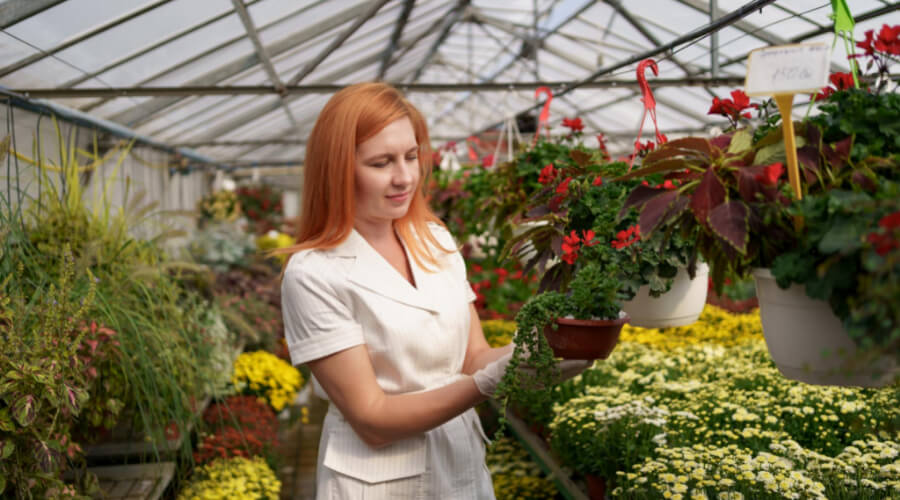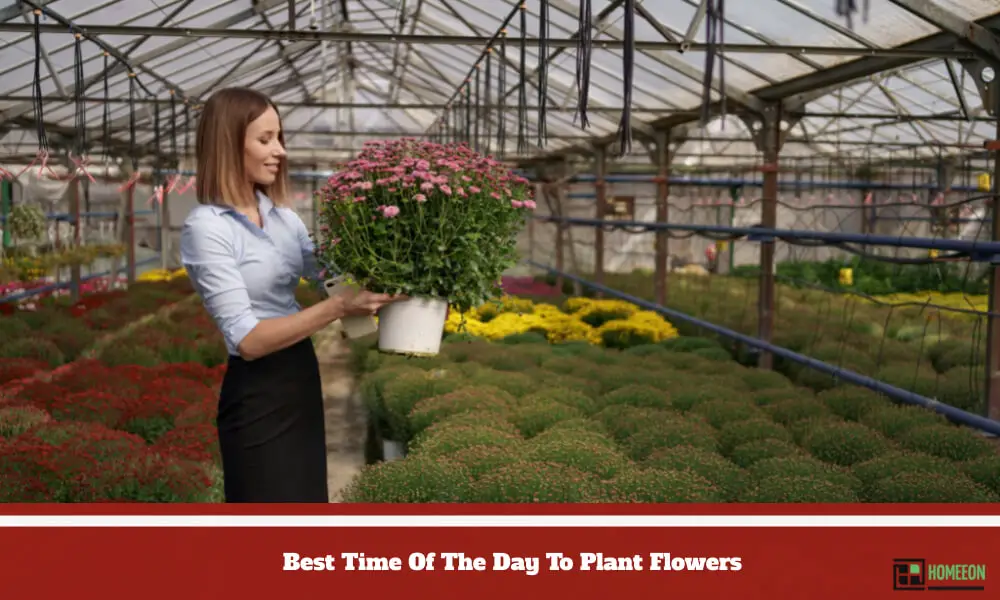Last Updated on July 23, 2023 By Emma W. Thomas
The best time of day to plant flowers is early morning or late afternoon. During these periods, the temperatures are cooler, reducing stress on the plants. Additionally, it allows the flowers to establish their roots before the heat of the day, leading to better growth and survival rates.
Is It Better To Plant Flowers In The Morning or Evening?
Both morning and evening present viable times for planting flowers, but they each come with their advantages and disadvantages. The choice depends on the gardener’s personal schedule, the specific plants being grown, and the local climate conditions. As a rule of thumb, it’s wise to avoid the heat of the day, as high temperatures can lead to heat stress for new plantings.
Morning vs Evening Planting
| Aspect | Morning | Evening |
|---|---|---|
| Temperature | Cool, increases over the day | Cool, decreases overnight |
| Light Levels | Increasing over day | Decreasing over evening |
| Water Absorption | High, before the midday heat | High, but the risk of staying moist too long |
| Acclimatization Time | The whole day before the night | The whole night before the day |
| Disease Risk | Lower | Higher due to the potential for overnight moisture |
| Convenience | Requires early start | Maybe more leisurely, but lower light levels |
What Are The Factors That Influence The Best Time Of The Day To Plant Flowers?

Several factors play a role in determining the best time for planting flowers, including;
Temperature
Most seedlings and starter plants experience some shock after transplanting. Their leaves may droop or wither for some moment after planting, and heat from the sunlight can cause irreparable damage. It is best to plant the flowers when the temperatures are low (like early morning or late afternoon) to prevent such damage. Planting at this time gives the plants enough time to recover from the shock before getting exposed to the hot sunshine.
If you are planting during hot weather, it is more practical to do it late in the afternoon. Ensure that you water the flowers to give them adequate time to absorb the water before the sun rises in the morning.
Seeds
If you are planting seeds, ensure that the earth is warm and well-watered. This practice will encourage the newly planted seeds to swell and their new stems to sprout. Your seeds need enough time to sit undisturbed in the soil before there is a heavy rainstorm. It is, therefore, necessary to check the weather forecast.
Weather
It is also crucial to plant your flowers when the weather is conducive. For example, it is not advisable to sow when windy as this can destroy the plants. Since winds slow down late in the evening and remain calm throughout the night, ensure that you plant your flowers when it is not windy. Make sure also that you check the weather forecast and look out for still days.
The Phases Of The Moon
According to ‘National Geographic’s most gardeners have embraced the practice of planting by the phases of the moon. It is believed that planting biennials and perennials, seedlings, and bulbs is best done in the moon’s dark. Some authorities recommend planting in the darkness of the moon at night before a new moon waxes again. Most gardeners believe that when you plant seeds in the dark of the moon, they will sprout faster, grow rapidly, and produce more yield.
Which Is The Ideal Time To Plant Seeds?
Seeds do well when planted in the morning since they will get what they need to germinate and are less prone to dangers. Since seeds require warmth to germinate, planting them in the morning will expose them to sunlight which will help them this warmth. The seeds will also get the essential moisture during their initial 12 hours in the garden bed.
Seeds are sensitive to dryness and require a constant level of humidity. Planting in the morning also protects seeds from attack by rodents.
Which Is The Right Time Of The Year To Plant Flowers?

The best time of the year to plant your flowers depends on whether you are growing perennials or annuals. Before you can plant your seeds, it is necessary to understand your region’s spring and fall frost dates, as this will help you know when it is safe for your plants.
For perennials, planting seeds may require starting earlier than other flowers since they may take longer to sprout. If you are planting mature perennials from a nursery, the fall is ideal.
The following table shows different perennials, the best time to plant seeds indoors, and when to plant outdoors.
Flower | When to start growing seeds indoors (number of weeks before the last frost date) | When to plant outdoors |
Anise Hyssop, Catmint, Columbine. Coreopsis, Coneflower (Echinacea), Gaillardia, Helianthus, Hibiscus, hollyhock, Thyme, Yarrow. | 8 weeks to 10 weeks | On the last frost date |
Phlox (perennial), Heliopsis, Foxglove (Digitalis), Asclepias (Milkweed) | 10 weeks to 12 weeks | One to two weeks after the last frost |
Dianthus, Delphinium, Daisy, Foxglove, | Ten to twelve weeks | Between one and two weeks before the last frost date |
The annual flowers, sprout, grow, and bloom in one season. These plants also seed in the same season and die during winter. Annuals are easy to grow.
The Table Below Gives A Summary Of When To Grow The Flowers, Both Indoors And Outdoors.
Flower | Number of weeks to plant seeds indoors (before the last frost date) | When to plant outdoors |
Allium, ageratum, aster, bachelor button, celosia, cosmos, Gomphrena, marigolds, Nicotiana, salvia, scabiosa, statice, strawflower, | Six weeks to eight weeks | On the last frost date |
Alyssum, calendula, Delphinium (annual), | Six weeks to eight weeks | One to two weeks before the last frost |
Coleus, impatiens | Eight weeks to ten weeks | Between one and two weeks after the last frost |
Zinnia | Four weeks to six weeks | One to two weeks after the last frost |
Petunia, phlox (annual), snapdragon, stock, verbena, | Eight to ten weeks | On the last frost date |
Sunflower | Three to four weeks | one to two weeks after the last frost date |
Does The Planting Time Affect Flower Health?
Planting time indeed has a significant impact on the health and robust growth of flowers. Specific times of the year tend to be more suitable for certain kinds of flowers and subsequently dictate their overall health. Below is a comprehensive explanation of how planting time can affect flower health.
1. Optimal Growth Conditions
- The majority of flowering plants prefer being planted either during the fall or early spring when the temperature is comparatively favorable.
- This timing allows for the best possible conditions for root growth, leading to healthier, more robust plants.
2. Plant Dormancy
- Planting flowers during periods of dormancy (usually winter for most species) can reduce the stress that’s often associated with the transplantation process.
- This promotes better establishment and survival rates, thus resulting in healthier blooms.
3. Nutrient Uptake
- Cool weather, as experienced in spring or fall, encourages the uptake of nutrients and water, vital components for the growth and health of flowers.
- On the contrary, planting during the hot summer months can lead to unnecessary stress and plant dehydration, negatively impacting flower health.
4. Pest and Disease Exposure
- Planting time can also influence the degree of exposure to pests and diseases. For instance, some insects and diseases are more prevalent during certain periods of the year than others, affecting plant health.
5. Flowering Time
- The timing of planting also affects the bloom time of flowers. Some flowers, such as bulbs and perennials, need a chilling period to produce vibrant, healthy blooms.
- Therefore, planting them in the fall ensures they experience this beneficial cooling period.
Summary Table
| Impact On Flower Health | Spring & Fall Planting | Summer & Winter Planting |
|---|---|---|
| Optimal Growth Conditions | High | Low |
| Plant Dormancy | High (particularly Fall) | Low |
| Nutrient Uptake | High | Low |
| Pest and Disease Exposure | Varies (dependent on flower type) | High (particularly Summer) |
| Flowering Time | Regular | Delayed |
Conclusion
Planting flowers is an excellent way to add seasonal colors to your garden. But, unless you do it at the right time of the day and year, this exercise could be a frustrating one. For most flowers, the best time to plant is early in the morning before the sun becomes too hot and late in the afternoon; it is also ideal for growing the flowers on a calm day since planting when it is windy could blow off the seeds.
Depending on whether you are dealing with annuals or perennials, you will need to know your area’s spring and fall frost dates. Be sure to plant during the suitable season for your flowers to be safe.
References:
https://www.plantician.com/what-is-the-best-time-of-day-to-plant-flowers-in-your-garden/
https://www.backyardboss.net/what-is-the-best-time-of-day-to-plant-flowers-in-your-garden/
Emma is a graduate of Domestic Science or Family and Consumer Sciences (Home Economics) from the University of Wisconsin. She has 7 years of experience Working with the strategic section of BestBuy and now writing full-time for Homeeon.
From Managing the Home, Interiors, Cleaning, and Exteriors to Gardening and everything about Making A Home Liveable – is her passion and this Homeeon is the result of this.
Emma loves decorating her home with the best stuff found online. She cares about quality over anything and writes reviews about them here in Homeeon. Get in touch with her over Pinterest.
Keep reading her blogs.

